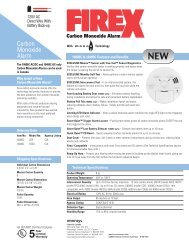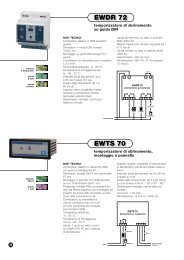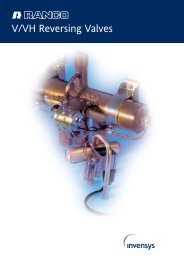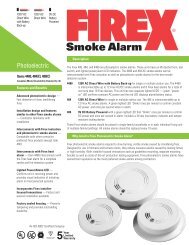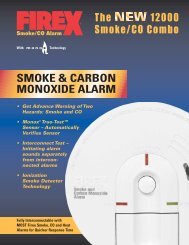SMOKE/CARBON MONOXIDE ALARM MODEL FADCQ - FireX
SMOKE/CARBON MONOXIDE ALARM MODEL FADCQ - FireX
SMOKE/CARBON MONOXIDE ALARM MODEL FADCQ - FireX
You also want an ePaper? Increase the reach of your titles
YUMPU automatically turns print PDFs into web optimized ePapers that Google loves.
The Dangers of Fire<br />
Fire is Unpredictable<br />
• Fire can burn a two-story home to the ground<br />
in minutes.<br />
• Fire can elevate air temperatures at eye-level<br />
to over 1200˚F (650˚C)!<br />
• In a typical home fire you have just minutes to<br />
escape, which is why it is so important to<br />
have at least one smoke alarm on every level<br />
of your home and in every bedroom or sleeping<br />
area.<br />
Depending on the source, materials involved,<br />
and environment, fire can spread rapidly or<br />
smolder slowly for hours.<br />
Different Types of Smoke Alarms<br />
Ionization smoke alarms are generally more<br />
effective at detecting fast, flaming fires which<br />
consume combustible materials rapidly and<br />
spread quickly. Sources of these fires include<br />
paper burning in a waste container or a<br />
grease fire in the kitchen. Photoelectric<br />
smoke alarms are generally more effective at<br />
detecting slow, smoldering fires which smolder<br />
for hours before bursting into flame.<br />
Sources of these fires may include cigarettes<br />
burning in couches or bedding.<br />
NOTE - This <strong>FADCQ</strong> alarm uses only an ionization<br />
type detector for sensing smoke.<br />
You may wish to consider installing<br />
other photoelectric alarms or combination<br />
ionization/photoelectric dual<br />
sensor alarms in your home for<br />
increased protection.<br />
7<br />
The Dangers of CO<br />
Carbon Monoxide (CO) is a Toxic Gas<br />
Carbon monoxide poisoning is a serious issue.<br />
Many families suffer daily, and over one thousand<br />
lives are lost each year because of this<br />
deadly household gas.<br />
• You cannot see, smell, or taste CO.<br />
• The effects of CO poisoning can cause household<br />
members to become extremely ill or even<br />
cause death.<br />
• CO poisoning can happen almost anywhere.<br />
Many appliances like furnaces, ovens, fireplaces,<br />
kerosene heaters, and grills may<br />
silently emit CO because of damage, poor<br />
maintenance, or defects.<br />
Understanding How CO Forms<br />
Appliance Malfunction: CO forms when<br />
fuel burns without sufficient oxygen (incomplete<br />
combustion). This type of malfunction<br />
can happen to any fuel-burning appliance<br />
at any time.<br />
Environmental Conditions: Example:<br />
Fireplace chimneys can fill with leaves during<br />
the fall season. If enough leaves, dirt, and<br />
soot are accumulated in the chimney, proper<br />
ventilation will be interrupted. This can cause<br />
a backdraft of CO into the home. The result<br />
can be fatal. With proper maintenance and<br />
cleaning, however, the potential for CO build<br />
up can be reduced.<br />
WARNING<br />
BE AWARE OF COMMON SOURCES OF<br />
<strong>CARBON</strong> <strong>MONOXIDE</strong>. See Chapter VII for<br />
details.



